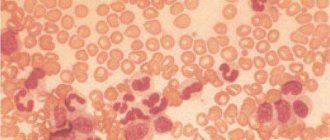Blood insulin levels
For females and males, hormone levels range from 3-25 µU/ml. If the hormone is below normal, it is a signal of overwork.
For a child, an insulin level of 20 is normal. For older people, the upper insulin level is 34. High levels of the hormone with normal sugar levels in women occur during pregnancy.
Any elevated levels of the hormone in the blood with normal sugar serve as a pretext for immediately contacting a doctor. Increased insulin in the blood means that diabetes is developing in the body.
Insulin in children is normal - Diabetes mellitus
To digest food, the human body produces a large number of different hormones.
Particularly important is insulin, which ensures metabolic processes in cells.
The level of this hormone in a healthy person should not go beyond certain limits.
If its indicators go beyond the required limits, this will most likely result in various pathologies. Because of this, it is important to monitor its level, as well as to know what level of insulin in the blood is satisfactory.
The role of insulin in the blood
Insulin is a type of hormone that helps transport nutrients throughout the body and is produced by the pancreas.
Insulin in the blood has many different functions. The main ones are:
- delivery and assistance in the absorption of glucose by muscle and fat cells;
- implementation of the process of creating glucogen in the liver;
- controlling the process of protein synthesis, due to which they break down more slowly, which contributes to their accumulation in fat cells;
- activation of glucose metabolism;
- inhibition of the functions of proteins that break down fats and glycogen;
- transportation of potassium, magnesium, calcium and other useful substances.
Carrying out its tasks, insulin takes part in every metabolic process. As a result, it is the main hormone that maintains carbohydrate balance in the human body.
That is why any violation in the amount of insulin leads to uncontrolled weight gain or unexplained fatigue. Such symptoms should force a person to see a doctor in order to find out whether his insulin is normal.
Normal insulin levels
The level of insulin in the blood indicates problems with metabolic processes. It is measured in micro units per liter (mu/l).
The amount of this hormone is not constant and varies depending on the number of years lived and when the analysis was performed.
Why does insulin in the blood increase (hyperinsulemia)
Repeated meals full of carbohydrates provoke an increase in insulin levels.
The reasons for the increase in hubbub are:
- malnutrition,
- excessive exercise,
- taking certain medications
- stress.
For those who are used to eating a lot of sweets, insulin is higher than normal. Also, an increased level of the hormone in the blood is typical for women, as they often experience stress and severe anxiety.
Obesity in men and women is associated with increased insulin. The development of infectious diseases increases the production of the hormone.
Increased insulin in a child occurs when there is an abundance of growth hormone.
Signs of High Insulin Levels
People who are overweight are most often diagnosed with type 2 diabetes.
During the release of insulin into the blood, typical symptoms are:
- impotence,
- heavy sweating,
- dyspnea,
- muscle pain, cramps,
- itchy skin, prolonged wound healing.
The constant feeling of hunger is the reason why insulin is elevated.
The described signs of elevated hormones are classified as other diseases, but by conducting additional tests, you can detect the problem in time and make a diagnosis.
For women, symptoms of increased insulin in the blood provoke anxiety, which is why diseases are more often diagnosed in them at the initial stage.
What does high insulin lead to?
Increased insulin promotes the accumulation of fat mass.
High levels of the hormone in the body are:
- decrease in blood sugar,
- the risk of the formation of benign tumors that develop into cancer,
- impotence, severe excitability of the nervous system, attacks of rage,
- deterioration of the condition of capillaries, organs of vision, kidney damage, development of atherosclerosis,
- slow healing of wounds, development of diabetic foot, gangrene,
- decreased bone strength,
- formation of seborrhea, acne, oily skin.
Often, hypertension is added to the symptoms of high insulin, which complicates health with stroke and heart attack.
When a child has elevated insulin in the blood while glucose is normal, this is a sign of pancreatic disease.
Low hormone levels
Reasons for decreased insulin levels in a child’s body:
- type 1 diabetes mellitus;
- binge eating;
- intake of large amounts of foods rich in monosaccharides;
- infectious diseases;
- inflammatory pathologies;
- stress;
- reduced physical activity.
Symptoms
When measuring blood sugar levels, the presence of hyperglycemia is determined. The child asks to drink and eat frequently, and there is a pathological increase in the number of urinations.
The baby eats a lot, but does not gain weight. The skin and mucous membranes are dry, the level of vision decreases, and pathological rashes may appear that do not heal for a long time.
Hyperglycemia is a manifestation of a lack of insulin in the body
Important! Hyperglycemia can lead to ketoacidotic coma if timely qualified assistance is not provided.
How to measure insulin in blood
High insulin is a health hazard. To see the condition of the pancreas, it is important to be examined.
For research use:
- glucose relationship test,
- analysis for the presence of high levels of the hormone (done on a lean stomach).
Following a diet for 3 days allows you to get the most authentic results.
If you are examined on a full stomach, the pancreas will produce the hormone in inflated quantities, which will give incorrect information.
This rule does not apply to children. Even on a full stomach, their hormone levels do not change.
What to do to self-test for high blood insulin
You can detect high insulin, which causes diabetes, at home using a glucometer.
After washing your hands, you need to warm up your finger to increase blood circulation. To reduce pain, an injection is given on the side of the finger. The first drop is wiped off, and the second is applied to the test strip for examination.
You can take 5 measurements per day - this allows you to get genuine results. If the insulin level is elevated, but glucose is normal, then these are symptoms of the development of hyperinsulemia (a condition foreshadowing the onset of diabetes).
What methods are used to control indicators?
There are several ways to determine whether the level of insulin in the blood is normal or whether it is outside the acceptable range.
Blood analysis
The patient donates biomaterial on an empty stomach in a laboratory setting. For the result to be correct, it is necessary to prepare for collecting the material. To do this, the last meal should be no later than 10-12 hours before the time of blood sampling. In the morning you can only drink water or mineral water without gas.
Important! You should avoid tea, compote, and fruit drinks, since the glucose in them can cause the release of insulin into the blood. The result is that the result will be false positive.
You also need to stop using toothpaste, chewing gum, and smoking.
Determination of glucose tolerance
This research method is based on the fact that the patient donates biomaterial several times. The analysis is carried out in the morning on an empty stomach, capillary or venous blood is taken. Next, laboratory workers dilute glucose powder in water, the patient drinks this solution, and after a certain time (usually 60, 90 or 120 minutes) blood is drawn.
GTT is one of the methods for diagnosing insulin levels in the bloodstream
It is important to carry out the fence in the same way as the first time. If desired, the attending physician can indicate after what period of time he needs to evaluate insulin levels in the blood.
Why do insulin levels change throughout the entire analysis period? The fact is that glucose powder is a sweet substance that provokes a rise in blood glucose and the release of insulin from the pancreas. All these changes are observed in blood parameters over time.
Sugar measurement
This method is effective for clarifying whether the level of insulin in a child’s blood is normal or whether the levels are outside acceptable limits. Glycemic levels are measured in several ways:
- analyzer in laboratory conditions;
- glucometer at home.
These measurements will not show the exact figure, but will help determine an increase or decrease in the level of a hormonally active substance.
Important! If blood sugar is above 5.5 mmol/l, we can think of low insulin levels, and if glycemia levels are below 3.3 mmol/l, we are talking about hyperinsulinism (high levels of the hormone).
Measuring glycemia with a glucometer:
- Thoroughly wash the hands of the child and the person who will take the measurements. Treat your baby's finger with alcohol or another disinfectant solution. Wait until your finger is completely dry.
- You can use not only your finger, but also your earlobe and heel (depending on the age of the baby).
- Set up the glucometer by inserting the appropriate test strip treated with chemical reagents into it.
- Prick the child's finger with a special device that is included with the glucometer.
- A drop of escaping blood must be applied exactly to the location on the test strip indicated according to the instructions.
- After a certain amount of time (usually from 10 to 40 seconds), the result of the glycemic measurement appears on the screen of the portable device.
Insulin levels can also be checked using a glucometer
Therapy and normalization of insulin
Before starting therapy, you need to find the cause of increased insulin in the blood. After this, the doctor prescribes treatment aimed at eliminating the root cause and lowering the hormone. Increased insulin with elevated sugar levels contributes to dehydration and can be fatal.
Medicines
It is prohibited to take medications on your own to stabilize the pancreas.
This threatens the emergence of additional complications. Treatment for elevated blood insulin in adults includes taking medications that reduce appetite, blood pressure, and a decrease in hormone levels.
Folk remedies
It is impossible to fight high insulin levels in the blood exclusively using traditional methods; you can only stabilize it.
For this they use:
- juices of beets, carrots, sauerkraut, potatoes,
- buckwheat with kefir,
- bay leaf decoction.
Elevated insulin levels can be stabilized if you use all folk remedies together with medications and exercise therapy.
Diet
You can stabilize your pancreas if you follow your doctor’s advice regarding food. If you eat healthy foods, elevated insulin in the blood can be lowered or the negative consequences of the pathology can be reduced.
The diet includes an abundance of low-fat dairy products, cereals, lean meat, eggs, fresh or boiled vegetables, natural juices, as well as fruits, with a small amount of sugar and vitamin C.
If insulin is elevated, it is recommended to consume:
- cherries, apples,
- citrus,
- kiwi,
- currant.
In type 2 diabetes, the diet is not made for a short period, the patient follows it throughout his life. If the hormone is elevated, adhere to the following dietary rules:
- multiple meals in small portions,
- exclude alcohol,
- replace sugar with sweeteners,
- reduce salt intake,
- eliminate the consumption of canned food, fast food,
- controlled carbohydrate intake, it is important to divide them evenly throughout the day.
By following a diet, you can get rid of extra pounds.
Exercise therapy
When insulin levels are high, it is useful to engage in physical therapy. Exercises allow you to maintain your health at a satisfactory level or improve your well-being. If insulin levels are high, the doctor should recommend a specific group of exercises. But before starting to implement the recommendations, the patient is given an ECG.
While performing the exercises, monitor your heart rate, measure your blood pressure, and check your insulin levels in the blood. If your readings increase, you should consult a doctor.
Physical therapy has a positive effect on the body, including:
- the relationship between cells and hormones increases,
- improves blood circulation, heart function,
- the risk of complications is reduced,
- prevention of heart attack and stroke.
You should not do exercises on a skinny or full stomach. Before class, you need to eat a sandwich or several. Reduce the number of diabetes pills or the dose of the hormone.
The lesson is immediately carried out under the supervision of medical personnel. This is done so that, if necessary, it is possible to adjust the duration and types of exercises.
norm in the child’s blood, administration regimen, dosage
Insulin for children is necessary for high blood sugar levels. The pancreas is responsible for producing the hormone. If its functioning is disrupted, problems are recorded with the production of vital components, which negatively affects the general condition. Insulin replenishes energy costs by distributing glucose throughout tissues and cells.
Functional purpose of the hormone
After eating food and entering it into the body, an active process of breakdown into small particles begins. Monosaccharides are needed to replenish energy reserves and distribute them throughout tissues and cells. The presented substances are a kind of building material. If they are deficient, the child’s well-being deteriorates sharply.
Every meal is accompanied by an increase in blood sugar levels. The signal about its receipt is transmitted to the pancreas. The organ responds to this action by producing insulin. He is responsible for transporting the active component throughout the body.
The main function of insulin is to replenish energy reserves. Secondary properties include:
- Stimulation of fatty acid production;
- Activation of protein production;
- Inhibition of glycogen breakdown;
- Preventing the breakdown of fat cells;
- Inhibition of the breakdown of protein components.
Insulin is responsible for the normal functioning of the body and metabolic processes. In case of its insignificant production, energy reserves are reduced.
Norm and deviations
The level of insulin in a child’s blood does not exceed 20 µU/l - this is the allowed maximum; any indicator beyond the presented figure poses a potential health hazard. The minimum indicator fluctuates around 3 µU/l. The figures presented are relevant for children under 12 years of age. In the blood of older children, the permissible values increase. The maximum is 25 µU/L, and the minimum is 3 µU/L.
Overestimated figure
High insulin is accompanied by the development of a hypoglycemic state. An overestimated indicator leads to serious consequences. Under its influence, the cells gradually atrophy, which is dangerous for the development of neurological abnormalities in the brain.
Reasons why insulin levels are elevated:
- Benign neoplasms localized in the pancreas;
- Diabetes mellitus type 2;
- Surgical interventions aimed at partial removal of the stomach or intestines;
- Disturbances in the functioning of the nervous system;
- Infectious lesion of the body;
- Poor nutrition;
- Increased physical activity.
A sharp jump in the hormone is accompanied by passivity. The child gives up his favorite activities in favor of relaxation. Fingers tremble, lower lip twitches. The baby is hungry, he constantly asks for food, but he does not gain weight; on the contrary, his weight loss is recorded.
Underestimated figure
With low insulin, the child experiences a deterioration in his general condition. The baby refuses to eat, does not want to play and do his usual activities. It is noteworthy that the symptoms of a low indicator have something in common with a high one. At the same time, the provoking factors of development vary.
Insulin is reduced in the following cases:
- Diabetes mellitus type 1;
- Excessive food consumption;
- Abuse of sweets;
- Infectious and inflammatory diseases;
- Low physical activity.
Laboratory tests will help determine the amount of sugar in the blood. It is impossible to detect insulin levels based on clinical manifestations.
How to control sugar levels?
Experts identify several methods that allow you to determine the reliable level of insulin in the blood. These include:
- Blood analysis;
- Glucose tolerance;
- Sugar measurement;
- Glycemic measurement.
Blood analysis. The collection is carried out on an empty stomach from a finger. To determine tolerance, it is necessary to donate blood several times. You will need material from a vein and finger. The collection is carried out three times, after an hour, an hour and a half and two. After the first test, the child needs to drink glucose.
Sugar measurement is carried out using an analyzer (the test is carried out at home) and a glucometer (manipulation is carried out at home). Important: it is impossible to calculate the exact figure according to the presented method. Measuring sugar is appropriate only if the deviation is determined upward or downward.
Modern medicine has many adapted instruments and devices. To determine your blood sugar level, just use a glucometer. The child needs to thoroughly wash his finger, heel or earlobe (depending on the chosen location for blood collection) and prick the skin. A drop of biological material is applied to a special strip, which shows a reliable result in a matter of minutes.
Types of insulins
The modern pharmacological market is represented by a mass of adapted medicines. Based on the duration of exposure, they are distinguished:
- Fast-acting drugs (Actrapid NM, Insulrap SPP). The level of insulin in the blood normalizes 30 minutes after administration, the effectiveness remains for 8 hours;
- Medium-acting drugs (Monotard HM, Humulin N). The active effect is observed 60–180 minutes after administration;
- Long-acting solutions (Ultratard HM). Efficiency is recorded within 28–36 hours
Other types of drugs can also raise insulin levels. They are of animal and human origin. The latter type of insulin is in demand; it helps to quickly restore the level of the indicator in the blood and maintains a positive effect for a long time.
According to the degree of purification, all drugs that reduce insulin resistance are divided into traditional, monopeak and monocomponent. In childhood, the same medications are prescribed as for adults. The only difference is the dosage.
Administration regimens
Only the attending physician can determine the optimal dose of insulin for children. This is a purely individual process that does not tolerate errors. There are three main periods of hormone administration:
- In the first 5 years of life – no more than 0.5–0.6 units/kg body weight;
- After 5 years – 1 unit/kg body weight;
- In adolescence – 2 units/kg.
Difficulties in determining the optimal dosage arise during active puberty. The fragile body is in the “transformation” phase, which is accompanied by uncontrollable surges in sugar. Injections for insulin-dependent children are prescribed for special indications.
The recommended dose is not constant; it is adjusted during insulin therapy and depends on the age of the child. The key factor is the general condition of the patient and the individual characteristics of the body.
To determine the optimal dose, the child undergoes a routine examination annually in a medical facility. The check is aimed at correcting therapy. Important: insulin calculations, as well as the drugs themselves, are constantly changing.
Methods of administration
Insulin is administered to children in different ways. The hormone is “sent” into the body by puncturing the skin on the abdomen, upper thigh, shoulder, buttocks and back. The injection site does not matter and does not in any way affect the effectiveness of the injection.
For manipulation, a special syringe, pen or insulin pump is used. The latter method allows you to “send” a dose of the hormone into the body through a special dispenser. The supply of insulin is continuous. The device is on the child even at night, without causing discomfort or unpleasant sensations.
Constant injection of insulin through syringes often causes fear in children. Parents should take this moment into account and help their child cope with emotional stress. It is appropriate to discuss with your doctor the choice of a less traumatic method of dosing.
The need to administer insulin is not a death sentence. Children, like adults, live their usual lives, with minimal restrictions. A correctly selected dose of the drug has a positive effect on the body. If there are deviations in the normal indicator, it is advisable to consult a doctor for further adjustment of therapy.
▼We RECOMMEND YOU TO STUDY▼











